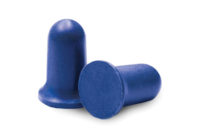
Reusable earplug handles ease removal and reinsertion.

Easy storing and access for muffs increases use in intermittent noise environments.
Communication and important information are sure to be lost in this environment, and problems can result. So a commonly asked question is: How do I communicate in this environment?
In all noisy environments, you should select products that avoid two conditions:
- Under-protection — inadequate hearing protection will lead to permanent hearing loss.
- Overprotection — many of the highest rated hearing protection devices (HPDs) protect hearing, but limit the ability to communicate. While decision-makers may think the greater the noise reduction rating (NRR) the better, overprotected workers may be unable to hear critical communications. The result is an inability to do good quality work — or worse — to hear warnings.
As a next step, you need to research different types of HPDs used in noisy environments. Noise levels in the range of 85 to 105 dBA are the most common, and for this range, stand-alone HPDs are an effective choice.
The most effective HPD for communication is the noise-filtering earmuff. With built-in microphones, it allows for listening over the widest range of noise. The electronic circuitry includes a gain limiter (limits sound to 82 dB) and impulse filter (shuts off/reopens the circuitry upon impulse noise). The circuitry filters out a large part of the undesirable noise, while enhancing speech frequencies in the range of 500-3,000 Hz. On the downside, the muff has a higher price — about four to five times the cost of a passive earmuff. In recent years, this option has become more affordable.
Passive earmuffs have a low life cycle cost, but are limited for listening. Passive muffs are a good choice for workers moving in and out of noisy environments. A user can remove muffs that allow for easy access. (One option is shown in photo 2.) Earmuffs, whether passive or noise filtering, offer effective noise protection, up to 105 dB. This is a result of the muff’s effective sealing around the ear.
Earplug performance varies depending on the user’s fit training and the shape of the ear canal. OSHA and NIOSH each recommend procedures for significant derating of the manufacturer’s published NRR rating. This is the reason the earplugs’ upper noise range is shown as 100 dB. More information on methods for estimating hearing protector attenuation can be found in OSHA 29CFR / 1910.95 App B.
Commonly used earplug products have some listening limitations. Corded reusables have an edge for lower noise environments, because their lower NRR rating allows some room for listening. Also, a reusable is more convenient for intermittent noise environments. Use of a handle (see photo 1) allows easier removal and reinsertion.
Disposable earplugs are the most commonly used plugs in industry. Two positive features are their hygiene — when used and disposed routinely — and their low cost. For listening ability, disposables have their limits. A well-fitted plug provides good hearing protection, but the time it might take for proper removal and reinsertion could be a drawback for intermittent noise exposure.
Bottom line
Audit your workplace for work conditions demanding hearing protection and clear communication between employees, and/or the ability to hear alarms and other warnings. Then select an HPD that meets your needs. Your objective is to allow users to hear critical communications and warnings, while protecting their hearing at the same time.
